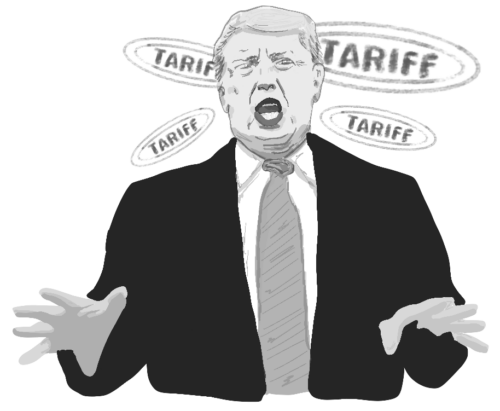One cornerstone of President Trump’s 2025 campaign was his “America First” foreign policy plan. Part of that vision centered around levying tariffs against U.S. trade partners, most notably Canada and Mexico, in the hopes that economic pressure would force America’s neighbors to address the steady influx of illegal immigrants and dangerous drugs like fentanyl, which the White House has labeled an emergency situation. The Trump administration believes that this force on American neighbors could force them to take action. China is also a target of these recently imposed tariffs, although those are an additional 10% on top of an existing tax.
In statements made by the White House staff, Trump suggested that substantial tariffs were necessary to force China, Canada, and Mexico to take action against illegal immigration and fentanyl inflow to the US. “More than 10 million illegal aliens attempted to enter the United States under Biden’s leadership, including a rising number of Chinese nationals and people on the terror watchlist,” read a memo released by the White House when the tariffs went into effect on Feb. 1. “Last fiscal year, Customs and Border Protection apprehended more than 21,000 pounds of fentanyl at our borders, enough fentanyl to kill more than 4 billion people.”
By President Trump and the GOP’s standards, these tariffs have been a resounding initial success. “@POTUS knows tariffs can bring countries to the negotiating table. It’s the art of the deal—using economic leverage to secure better outcomes for the American people,” tweeted the House Committee on Agriculture. Within a few days of their implementation, Mexico and Canada both brokered deals with the United States. As part of their deal, Canada has created a new “fentanyl czar” position, pledged $1.3 billion to secure its border with the U.S., and will list Mexican drug cartels as terrorist organizations. Mexico pledged to station 10,000 members of its National Guard along its northern border. In response, the tariffs will be paused for 30 days, but President Trump has pledged to enact new 25% tariffs on all steel and aluminum entering the U.S. on March 12. Canada is the largest exporter of both of those metals to the U.S. The Trump administration believes that “steel import levels and global excess were weakening our domestic economy and threatening to impair national security.”
Economics 10a: “Principles of Microeconomics” Professor Jason Furman ’92 does not share the President’s enthusiasm. “The question is, ‘Did he help his leverage by looking like he was willing to do really, really, big things, or did he hurt his leverage by making massive threats and getting really, really tiny things in exchange for them?’” Furman asked at an Institute of Politics Forum earlier this month.
Many Harvard economics concentrators have similarly felt unmoved by the last few weeks. “A lot of the tariff rhetoric that we’re seeing is mostly posturing,” said Michael Shaari ’27. “It’s probably going to have a lot of effect on the Fed’s decision to cut interest rates in the future, because tariffs are inflationary. And I think a lot of that comes with how Trump approaches deportation, because that’s also inflationary, but I think it’s mostly posturing.”
Aayush Kadakia ’26 was similarly unphased. “From an economic perspective, I think that the tariffs are more of a one-off, transitory increases in prices, rather than a true catalyst for reviving rampant inflation, so they might be better viewed as a pass-through tax on consumers with little expected response from the Fed,” he said. “Politically, there are so many different viewpoints out there… Thus far, tariffs have proven an effective negotiating toolkit.”
Looking at the human costs of Trump’s tariffs, there remains uncertainty around whether the President’s actions will help or harm these crises. In an interview with Business Insider, Laura Guzman, the executive director of the National Harm Reduction Coalition, voiced concern that the tariffs could make drug overdoses go up even if they are successful in slowing the influx of fentanyl into the country. “The biggest fear I had when I saw the negotiation to postpone the tariffs, immediately, my reaction was, ‘that is not going to be good for the folks that are impacted by both the war on drugs, but also by this tainted drug supply,’” Guzman said.
Guzman went on to clarify that, while slowing the rate of fentanyl entering the country is a good idea, there is still a large amount of fentanyl that is produced inside the United States. Disrupting the flow of drugs can create a situation where addicts are mixing narcotics that they don’t normally use, which can be fatal.
President Claudia Sheinbaum of Mexico voiced similar frustration. “If the United States government and its agencies wanted to address the serious consumption of fentanyl in their country, they can combat the sale of narcotics on the streets of their main cities, which they don’t do,” she said.
Ultimately, the impacts of Trump’s tariffs, while far-reaching, probably will not materialize for some time. Canada, Mexico, and the United States will continue to negotiate over the next three weeks, and the President’s course of action come the March 12 deadline will likely be a response to whatever happens during that period. Regardless of one’s stance, it is clear that President Trump is deploying the full powers of his office to enact the vision for America he so heavily boasted about on the campaign trail.
Jordan Wasserberger ’27 (jwasserberger@college.harvard.edu) is the Photo and Podcast Director of the Independent.

